Computer Graphics Survey
Sound Recording
Using SoundEdit 2.0 on MacOS Computers
| previous handout |
ACG Home |
Instructor Home |
Class Home |
list of tutorials |
next handout |
Before beginning the project
Read theinformation that pertains specifically to the way the ACG Lab operates. This section of the directions may not apply if you work on the project elsewhere.
- SoundEdit can be used for two distinct functions:
- Sound recording
- Sound editing and special effects.
- For our project, we will use both sets of features to create a soundtrack for the animation that will be displayed with our web pages.
- Our soundtrack will be an example of sampled sound, one of the major audio technologies that can be used in a web page. Other approaches include MIDI and speech synthesis.
- After deciding on the contents of our soundtrack, we will proceed to record. After the recording, you may want to trim and clean up the sounds you obtained.
- Ambience noises and/or background music.
- In filmmaking, this is known as wild sound, since it can be recorded separately, without a rigid relationship to the visuals.
- This type of sound is generally looped to save on file size. The duration of the sound loop doesn't have to match exactly the duration of the picture loop, since the two run independently. However, a very short loop may disguise the nature of the sound, and a very long loop needlessly increases file size.
- For the loop to work successfully, the start and end of the sound need to match (just like the start and end of the picture). Matching the endpoints of distinctively recognizable sounds (such as a voice singing) is a difficult job--you will have fewer problems if you choose a continuous, random noise like that of the surf, an engine, distant crowds, etc.
- Sound hits synchronized to specific events in the animation.
- In filmmaking, this is known as sync sound, and it requires more complex equipment so that it is recorded in lock-step to the camera.
- In animation, this type of sound is often recorded first. The visuals are created later to match a breakdown of the soundtrack called an exposure sheet. An especially important example of this technique is lip sync--matching the movement of the animated characters' mouths to the actors' dialog.
- The duration of this type of sound must match exactly the duration of the relevant visuals. To make this easier, SoundEdit allows you to measure sound lengths in frames--provided you specify the correct frame rate.
| return to top |
- Launch the SoundEdit application, found in the Sound folder on the hard drive.
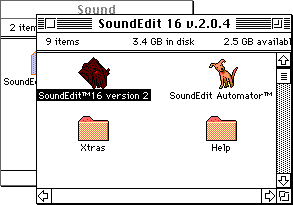
- Choose the command Apple menu-->Control Panels-->Monitors and Sound. In the dialog, click on the Sound button at the top. Choose your sound source from the Sound Monitoring Source menu (close the dialog when done):
- For an audio CD playing in the CD-ROM drive, choose 'CD'
- For a microphone (or other sound source plugged into the microphone connector), choose 'Sound In'
- If you selected CD, use the Apple CD Audio Player (in the Apple menu) to select a track for playback.
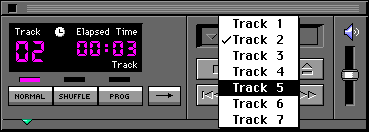
- Use the Sound Format command in the Modify menu to choose 8 bits for the Sample Size, and the lowest one of the Rates marked with a microphone icon (there may be only one such rate on some machines). Make sure to leave Compression turned off (just as we did for our scanned images, we don't want to reduce the recording's quality just yet, before effects and further compression are applied).
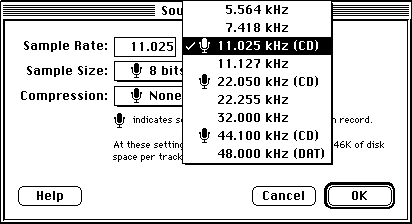
- Use the Ruler Units command in the View menu to choose Frames as the unit. In the field that appears next to Frames, enter the frame rate you selected in Director for your animation.
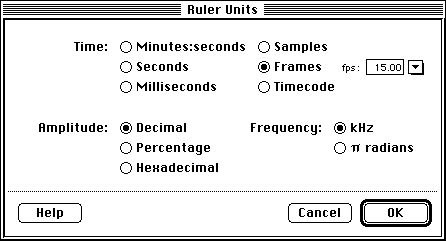
Unless you made changes to the default settings (using Director's Control palette), your animation's frame rate is likely 15 fps (frames per second).
- If necessary, use the Window menu to display the Levels palette. You may also have to expand the palette (clicking on its zoom box) to see the control sliders (as shown in the picture below). Start your sound source (or rehearse talking into the microphone), and adjust the recording sliders (indicated by the microphone icon) for the best levels: loud enough to show many green bars in the meter, but not so loud that yellow and red bars appear. In the example pictured here, the left channel (topmost in the display) is set too loud, while the right channel is too soft.

- Press the record button when your sound source is properly cued up.
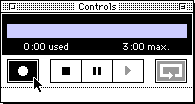
- Press the Stop button when done recording.
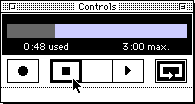
- A waveform graph representing the newly recorded sound will appear in the document window.
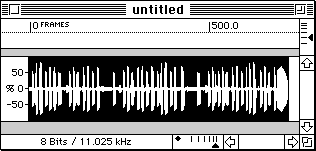
- If the computer you used did not support a low enough sample rate, the file will be quite large. While the window with your recording is active, choose again Modify-->Sound Format (this will now apply to the existing sound data). Choose 8 bits, 11.025 kHz, compression 'None', then click 'OK' to downsample the recording.
- Use the Save command in the File menu, choose Audio IFF as the file format. The filename can be anything you want, since the sound recordings will not end up on the web server directly.
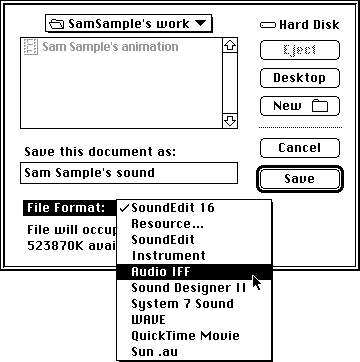
| return to top |
- Adjust the waveform display (using the slider at the bottom of the document window) to better see the parts you are interested in:
- Zoom in for a detailed view
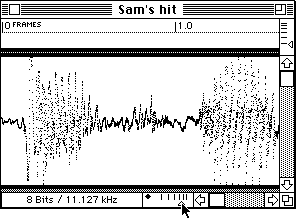
- Zoom back out to see the big picture
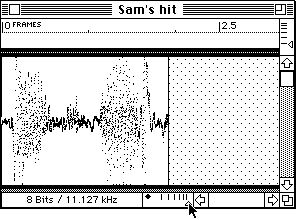
- Click in the waveform display, and drag to highlight the portion of the sound that you want to clean up.
- Verify that the selection matches the sound you want by using Play (in Control menu): only the selected portion of the sound will be heard.
- If Loop is checked in the Control menu, the selection will play back repeatedly. This is useful to check how long your ambience recording needs to be to sound right when looped.
- To easily identify and retrieve the selected portion of the sound, create a Label (in the Insert menu). When the highighted default label appears, enter a brief name for the selection.
- If you later click on the Label, the sound segment will be selected again, so you can go back to working with it.
- Labeled segments can be quickly selected and/or played using the Labels palette (Window menu).
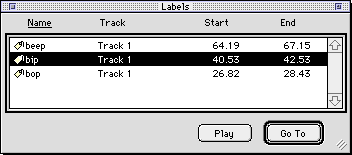
- While the segment is selected, it can be color-coded using the Color submenu of the Modify menu.

- To remove part of a sound, shortening the entire sound:
- Select the unwanted segment, then press the 'Delete' key
- The portion of the sound following the deleted segment automatically moves up to close the gap.
- To remove part of a sound, leaving a pause in its place (the overall length of the sound does not change):
- Select the unwanted segment
- Insert-->Silence. The duration listed in the dialog automatically matches the duration of the selection, so you can directly click 'OK'.
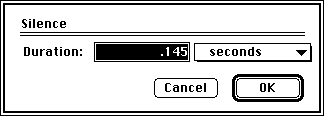
- In the waveform, a horizontal line will replace the selected segment. Replacing inaudible noise with pure silence improves file compression.
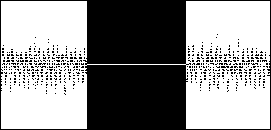
- To keep a portion of the sound, while eliminating the rest:
- Select the segment you want to keep
- Edit-->Crop. Parts of the sound outside the selection will be deleted.

- After using Crop, the sound will be left at the same position in the file--meaning that there will be some silence before anything is heard. This would make it hard to accurately synchronize sound and picture in Director.
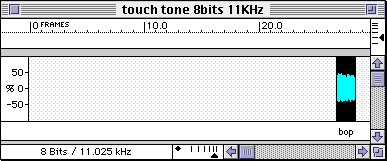
- Make sure to reset the sound offset to zero with the Modify-->Track Offset command. The waveform should start flush with the left margin of the document.
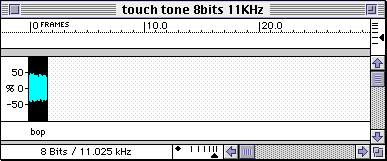
- To rearrange the sequence of sounds:
- Select the segment you want to move.
- Edit-->Cut.
- Click in the waveform to place the insertion point where you want the segment to go.
- Edit-->Paste.
- To replicate a sound:
- Select the segment you want to replicate.
- Edit-->Copy.
- Click in the waveform to place the insertion point where you want the copy of the segment to go.
- Edit-->Paste.
| return to top |
Notes
- MIDI files contain a list of the notes to be played by a music synthesizer
- The music synthesizer can be a piece of hardware hooked up to the computer, or a program running on the computer itself.
- MIDI files can efficiently represent extended pieces with small files--since the bulk of the information (instrument samples) is already built into the synthesizer.
- On the other hand, MIDI files can only play sounds for which an instrument is available in the synthesizer.
| return |
- Speech synthesis is the simulation of a human voice talking
- The speech sounds are usually created by a program running on the computer, although in some cases specialized hardware is used.
- Speech files are plain text, with optional commands to fine-tune the pronunciation. They too are small and efficient--since the voice data is built into the speech synthesizer.
- Unlike MIDI, there is at the moment no firm standard for speech synthesis. Using it in a web page, therefore, will reduce your audience to only those computers compatible with the particular speech program you used.
| return |
Information specific to the ACG Lab
On ACG Lab computers, the program SoundEdit is on the hard drive, inside the Sound folder.
After completing this step of the project, make sure to copy your sound recording files to your Zip disks. These files will be needed again for subsequent steps of the project.
Help for SoundEdit is available on the file server, in ACG_DOCS.
The Art Computer Graphics program of Fullerton College offers a class on sound recording and editing, ACG68-Sound for Multimedia. Find it in the ACG Class Schedule.
| return |
| previous handout |
return to top |
next handout |
|
This document originally at <http://acg2.fullcoll.edu/FACULTY/CORSI/LEARN/OVERVIEW/OV090MAC/INDEX.HTM>
|
Copyright 1997-99 by Sandro Corsi.
Last modified 18 OCT 1999.
|
SaneDraw home
|